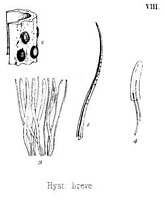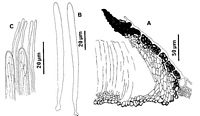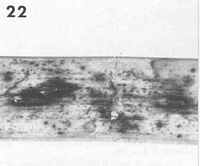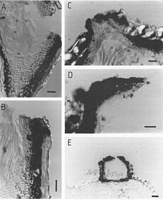|
 Terriera brevis Terriera brevis
SynonymsLophodermium breve
Hysterium breve
BiostatusPresent in region - Indigenous. Endemic
Images (click to enlarge)
Caption: plate LXVIII. Fig. VIII. 1, leaf and fungus of the natural size; 2, portion of the same; 3,
perithecium shewing the contained asci; 4, ascus; all more or less magnified. | 
Caption: Fig. 3 Lophodermium breve A, ascocarp margin in vertical section (type, K). B, asci (PDD
46121). C, apex of asci and paraphyses (PDD 46121). | 
Caption: Fig. 22 Lophodermium breve (PDD 46121). Macroscopic appearance of ascocarp (x15). | 
Caption: Fig. 12. Terriera breve (PDD 47493), development of
periphysoids, forming black shelf-like zone across top of hymenium. A, upper wall of
unopened ascoma in vertical section (upper wall broken during sectioning), showing broken
columns of palis | 
Caption: Fig. 38. Terriera breve (PDD 62551). Asci, apex of paraphyses,
and ascospores. |
Article: Johnston, P.R. (1989). Rhytismataceae in New Zealand. 2. The genus Lophodermium on indigenous plants. New Zealand Journal of Botany 27(2): 243-274 (http://www.rsnz.org/publish/abstracts.php).
Description: Ascocarps on Uncinia 0.6-1.2 x 0.2-0.3 mm, oblong-elliptic in outline with broadly
rounded ends, on Gahnia ascocarps 1.0-5.0 x 0.2-0.4 mm, often sublinear. Walls black with
paler zone along the future line of opening. Walls of mature ascocarps oriented steeply with
respect to surrounding host tissue, with black, flattened area adjacent to both sides of
longitudinal opening slit. Pycnidia absent.
Ascocarps in vertical section initially subepidermal, epidermal cells becoming filled
with fungal tissue as ascocarps mature. Hymenium surrounded by layer of vertically-oriented,
thin-walled, hyaline, cylindric cells. Upper wall 20-25 µm wide, of dark brown, thick-walled
cells, with a narrow extension, comprising very dark tissue, extending across top of
hymenium.
Paraphyses 1-2 µm diam., undifferentiated or slightly swollen at apex, extending 10-15
µm beyond asci. Asci 110-130 x 6-7 µm, cylindric, apex rounded, wall not thickened, 8-spored.
Ascospores 60-70 x 1.5-2 µm, 0-septate, with indistinct gelatinous sheath.
Habitat: Dead leaves of Uncinia spp. and Gahnia sp.
Distribution: Auckland, Coromandel, Campbell I.
Notes: The type specimen of this species (K) is fragmentary. Vertical sections were made from part
of one ascocarp from the type. Ascocarp structure was typical of L. multimatricum. Asci,
ascospores, and paraphyses were not clearly seen. Berkeley (in Hooker 1847) provided
illustrations, but no measurements of the hymenial elements.
Two recent collections from New Zealand, one on Uncinia (PDD 46121), and one on
Gahnia (PDD 37127) have the same kind of ascocarp structure as the type of L. breve. The
asci and paraphyses from these collections match the illustrations of Berkeley, and as L. breve
was originally described from an Uncinia sp., it is assumed that the recent collections
represent L. breve. The following description is based on the recent New Zealand collections.
L. breve was placed in synonymy with L. gramineum by Tehon (1935), however the
two fungi differ in ascocarp structure and in ascus width.
See also notes under L. multimatricum.
Article: De Notaris, G. (1847). Prime linee di una nuova disposizione de Pirenomiceti Isterini. Giornale Botanico Italiano. [Parlatore's] 2(2(7-8)): 5-52 Firenze:.
Article: Berkeley, M.J. (1845) [1847]. Fungi. Flora Antarctica. Part I. Botany of Lord Auckland's Group and Campbell's Island. The Botany of the Antarctic Voyage I Hooker, J.D. (eds.) 1-208 169-175 London: Reeve, Brothers.
Habitat: on the dead leaves of Uncinia Hookeri, Boott.
Distribution: Campbell's Island
Notes: This species is manifestly different from the small form of H. culmigenum, and the nature of
the asci and paraphyses are further distinct, being in the latter plant shorter and of a different
form, with the apices of the paraphyses curved or curled. The apiculate extremities may not
prove to be a constant character, though the probability is that it will, at least in full grown
specimens.
Article: Johnston, P.R. (2001). Monograph of the monocotyledon-inhabiting species of Lophodermium. Mycological Papers 176: 1-239.
Description: Infected areas on dead leaves, no paler than surrounding leaf tissue, not associated with zone
lines, containing scattered ascomata, conidiomata not seen. Ascomata on Uncinia 0.6-1-2 x
0.2-0.3 mm, oblong-elliptical in outline, ends rounded, on Gahnia 1-5 x 0.2-0.4 mm, often
sublinear, in unopened ascomata wall black with paler zone along future line of opening, in
opened ascomata wall black, oriented at high angle to surrounding host tissue, single,
longitudinal opening slit with narrow, black, shelf-like zone along either side. Ascomatal
insertion subepidermal. Ascomatal structure typical of Terriera (see p. 37).
Paraphyses 1-2
µm diam., undifferentiated to slightly swollen at apex, unbranched, embedded in thick gel,
extending as compact epithecium 10-15 µm beyond asci. Asci 110-135 (-160) x 6-7 µm,
cylindrical, tapering gradually to rounded apex with slightly thickened wall, 8-spored, narrow
basal stalk with spores extending 80-90 µm from ascus apex. Ascospores (55-) 60-75 x 1.5-2
µm, tapering slightly to ends, non- or 1-septate, gently curved or sigmoid on release, with no
gelatinous sheath.
Habitat: Carex, Uncinia, Gahnia (Cyperaceae).
Distribution: New Zealand.
Notes: Terriera breve is distinguished from the other monocotyledon-inhabiting New Zealand
species of Terriera by its undifferentiated paraphyses and ascus and ascospore size.
Asci from a collection on Gahnia (PDD 37127) are slightly longer (130-160 µm, vs 110-135
µm) than the other collections examined. However, in all other respects the fungi could not
be distinguished.
DE NOTARIS (I847) reported what he considered to be this species from Italy. DUBY
(1862) placed it in synonymy with Lophodermium arundinaceum var. gramineum (Fr.) Duby,
and this was accepted by TEHON (1935). However, this synonymy is incorrect, the
ascomatal structure of T. breve differing from that found in all European monocotyledon-inhabiting
species of Lophodermium.
|